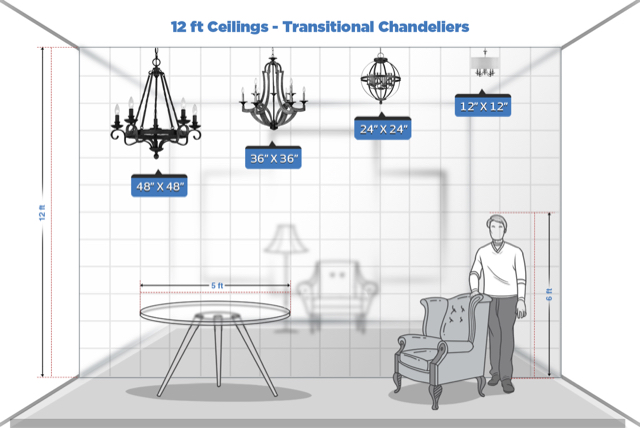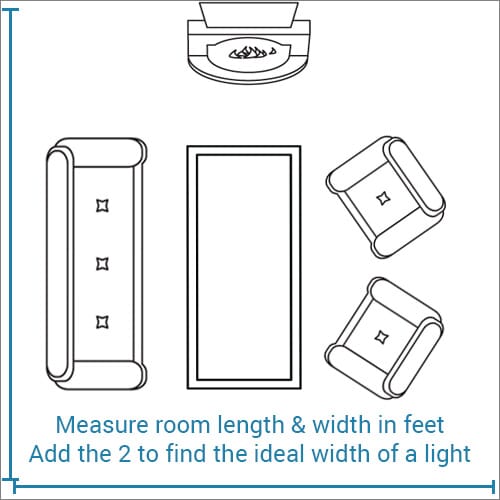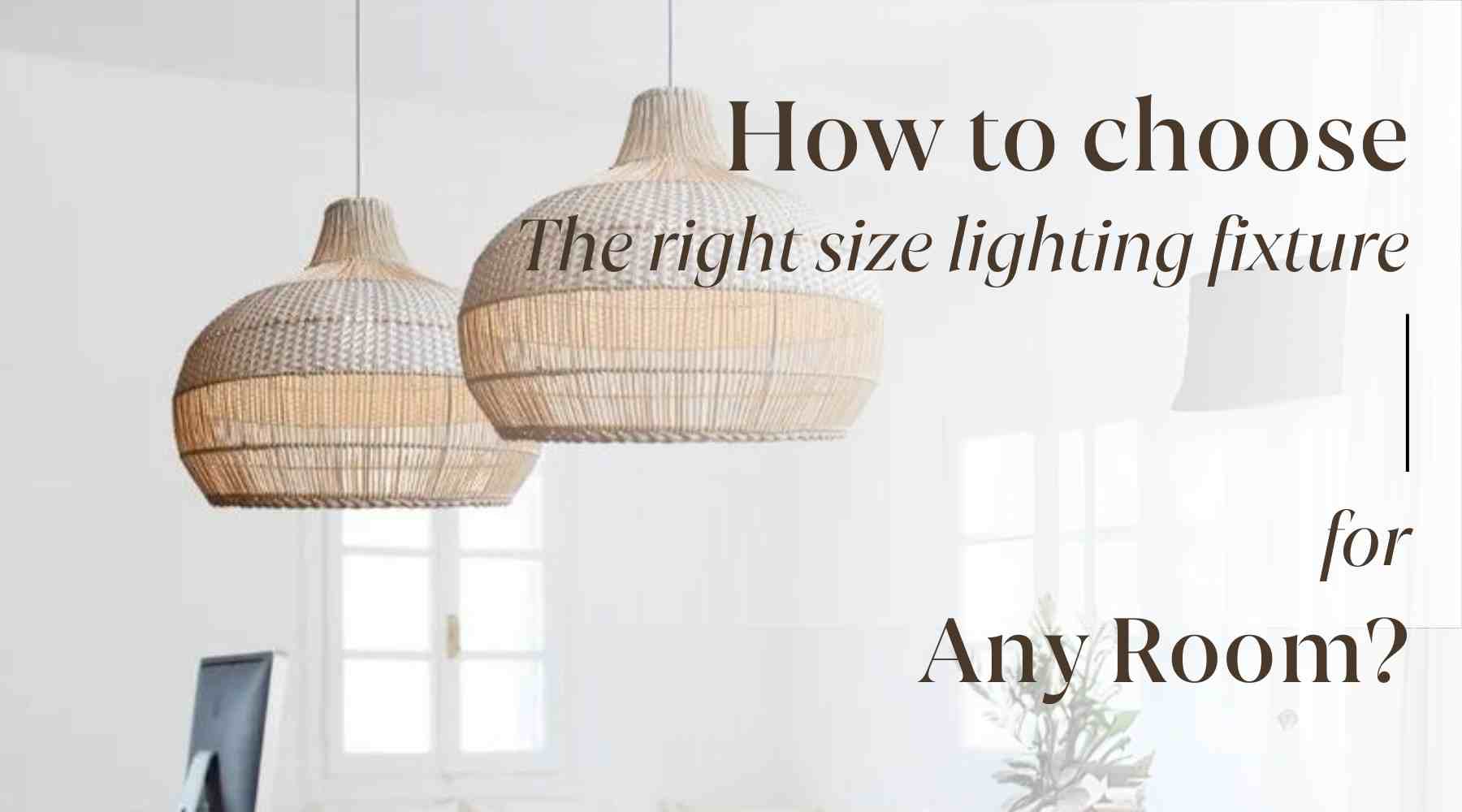Choosing the right size light fixture can transform a room. It balances aesthetics and functionality.
Proper lighting is crucial in creating an inviting atmosphere. But how do you decide what size light fixture suits your room best? The answer lies in understanding the room’s dimensions and purpose. A well-sized fixture enhances the space without overpowering it.
Consider the room’s height, width, and overall style. The fixture should complement the room’s furniture and decor. It’s not just about illumination; it’s about creating harmony. A fixture that’s too small might go unnoticed, while one that’s too large can overwhelm the space. By selecting the right size, you ensure a cohesive and stylish look. This guide will help you find the perfect light fixture size for any room, ensuring your space shines beautifully.
Choosing The Right Fixture Size
Measure the room length and width. Add those two numbers together. This total will help find the right fixture size in inches. For example, a room that is 10 feet by 12 feet, add 10 and 12. The fixture should be around 22 inches wide. This size keeps balance and looks good in the space.
Think about the height of the ceiling. Higher ceilings need taller fixtures. For low ceilings, choose flush or semi-flush mounts. The fixture should be proportionate to the room size. It should not be too big or too small. A well-sized fixture enhances the room’s beauty.
Impact Of Ceiling Height
Rooms with standard ceilings need light fixtures that fit well. A good rule is to choose a fixture that hangs no lower than 7 feet from the floor. This helps in avoiding bumps and gives enough light spread. Fixtures should not be too big or they will overpower the space. Balance is key. A small room with a low ceiling does well with a flush mount or a small chandelier.
High ceilings allow for more dramatic light fixtures. Choose a larger fixture to fill the space. Hanging chandeliers work well here. Ensure the fixture does not hang too low. This keeps the room feeling open. Large pendants or tiered chandeliers add elegance. These fixtures draw the eye upwards, highlighting the ceiling height. Proper size enhances the room’s beauty and function.
Fixture Size For Different Rooms
The living room often needs a bigger light fixture. Choose a fixture that is about 1/3 of the width of the room. This helps balance the space. A large chandelier or pendant light works well here. Make sure it hangs at least 7 feet from the floor. This prevents people from bumping into it.
In the dining room, the light fixture should be 1/2 to 2/3 the width of the table. It adds focus and elegance. Hang the fixture 30 inches above the table. This height provides enough light without glare. Choose a style that matches your dining room décor.
A bedroom light fixture should not be too big. Look for a size that is 1/4 of the room’s width. It creates a cozy and relaxing atmosphere. Hang the light 7 feet above the floor. This ensures proper lighting while sitting or lying down.
In a bathroom, fixtures must be functional and stylish. Choose a size that suits the space, often smaller. Consider wall sconces beside mirrors. They provide good lighting for grooming. Ceiling lights should hang high to avoid water splashes.
Calculating Fixture Diameter
Start with measuring the length and width of your room. Use feet for these measurements. For example, a room that is 10 feet long and 12 feet wide. Add these two numbers together. So, 10 + 12 = 22. This sum is very important. It helps you decide the size of the light fixture.
Use a simple formula to find the fixture size. Take the total room length and width. Convert this sum into inches. For the example room, 22 feet becomes 22 inches. This number gives you a good fixture size. Choose a light fixture with a diameter of 22 inches. This size is perfect for the room.
Fixture Height Guidelines
A light fixture should hang about 30-34 inches above a table. This height helps provide the right light. It also avoids bumping your head. For smaller tables, choose a smaller fixture. For bigger tables, go for a larger one. Always pick a light that fits the room size. Ensure the fixture is centered over the table. This way, it spreads light evenly. A well-placed light makes dinners special.
In entryways, the fixture should hang at least 7 feet above the floor. This allows people to walk under it easily. Choose a fixture that is one-third the width of the entryway. This size looks balanced and attractive. Keep the style simple and welcoming. Ensure it matches other home fixtures. A good light can make guests feel welcome.

Credit: www.hkinteriors.com
Balancing Multiple Fixtures
Open floor plans can be tricky for lighting. Spaces feel bigger and need more light. Use different fixtures to light up various areas. Balance is key. Large fixtures work well in big spaces. Smaller fixtures add light in corners. Mix styles for an interesting look. Make sure each fixture has a purpose. Avoid shadows by placing lights smartly.
Layered lighting adds depth. Layer with care. Use ceiling lights for general lighting. Table lamps add warmth. Spotlights create focus on art. Each layer must blend with others. Choose soft light for cozy spaces. Bright lights work for work areas. Balance light levels for comfort. Different heights create interest.
Common Mistakes To Avoid
Oversized fixtures can make a room look crowded. They may take up too much space. People may bump into them. They can also make a room feel dark. Large fixtures block light. Rooms need balance.
Undersized fixtures may look out of place. They can make a room feel empty. Small lights may not shine enough. Rooms need bright light. Small lights can get lost in big rooms. Choose fixtures that fit the room size.

Credit: www.franklinlighting.com
Expert Tips For Perfect Lighting
Light fixtures can change a room’s look. Pick a style that fits. A modern room might need sleek lights. Classic rooms love antique designs. Colors matter too. Match the fixture’s color with the room’s theme. Size is crucial. A small room needs a smaller light. Big rooms can handle large fixtures. But, don’t choose too big or too small. It can look odd.
Lighting affects the room’s mood. Bright lights are great for work areas. Softer lights create a cozy feel. Think about what the room needs. For reading, you need bright light. Relaxing needs dimmer options. Consider dimmer switches. They allow control over brightness. This can change the feel of a room quickly. Always test the light before buying. Make sure it meets your needs.

Credit: www.lightsonline.com
Frequently Asked Questions
What Size Light Fixture For A 12×12 Room?
Choose a light fixture with a diameter between 20 to 24 inches for a 12×12 room. Ensure adequate brightness by selecting fixtures with sufficient lumens. Consider the room’s decor and ceiling height for style and functionality. Proper lighting enhances space and ambiance effectively.
What Is The Rule Of Thumb For Lighting Fixtures?
The rule of thumb for lighting fixtures is to match the scale of the room and function. Choose fixtures that complement room size and style, ensuring adequate brightness for tasks. Consider height, spacing, and design to create balanced and effective lighting.
What Size Light Fixture For A 10×10 Room?
Choose a light fixture 20-24 inches in diameter for a 10×10 room. This provides balanced illumination. Ensure the fixture complements your room’s style. Proper lighting enhances room aesthetics and functionality.
How Big Should A Chandelier Be Based On Room Size?
Choose a chandelier with a diameter that equals the sum of the room’s length and width (in feet). For example, a room 12×10 feet should have a chandelier 22 inches in diameter. Ensure the chandelier’s height matches the room’s ceiling, maintaining balance and proportion.
Conclusion
Choosing the right light fixture size transforms your room’s atmosphere. Consider your room’s dimensions for a balanced look. Big rooms need larger fixtures. Smaller spaces benefit from compact lighting. Measure ceiling height to avoid awkward placements. Style impacts the overall vibe.
Modern rooms suit sleek fixtures; traditional spaces favor classic designs. Choose wisely for functionality and aesthetics. Remember, lighting sets the mood. A well-chosen fixture enhances comfort and style. Let light guide your design choices. Illuminate your space with care. Happy decorating!

